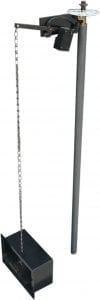Historical introduction to temperature measurement
The temperature measurement was preceded by a long period, throughout the 18th century, when first empirically and then gradually more accurately, have been developed measurement scales, were discovered fixed points for the calibration of these scales, and all physical variations related to temperature change: thermal expansion of gases, liquids, metals and other solids, liquefaction temperatures, boiling temperature, magnetism, thermoelectricity, just to give a few.
However, this is only when the shortage of charcoal, the rising price of heating means added with the need for precise temperature control, that were developed thermostats. The first one was made for incubators at the end of the 18th century, by the French engineer Jean Simon Bonnemain, with the first accurate bimetallic rod thermostat in 1788 (It was named at that time “Gouverneur du feu” or “régulateur du feu” (fire governor). It was used to control the water temperature of the first central heating boiler using the thermosyphon that he also invented.
In the first quarter of the 19th century, the huge development of the central heating by hot water or low pressure steam generalized various control systems, most of them in the low pressure steam boilers, and the arrival of electricity for domestic use in the late 19th century initiated the search for and discovery during the first 50 years of the 20th century almost all current systems thermostats.
 1788. The first rod thermostat named “Régulateur du feu” invented and built by Jean Simon Bonnemain, French engineer, to control the temperature of a Hatchery in the suburbs of Paris, heated by the first thermosyphon boiler also invented for the occasion.
1788. The first rod thermostat named “Régulateur du feu” invented and built by Jean Simon Bonnemain, French engineer, to control the temperature of a Hatchery in the suburbs of Paris, heated by the first thermosyphon boiler also invented for the occasion.
This is the direct ancestor of the rod thermostats made by JPC.
Functional reproduction at 1/1 scale made
by Ultimheat (height 900 mm)
